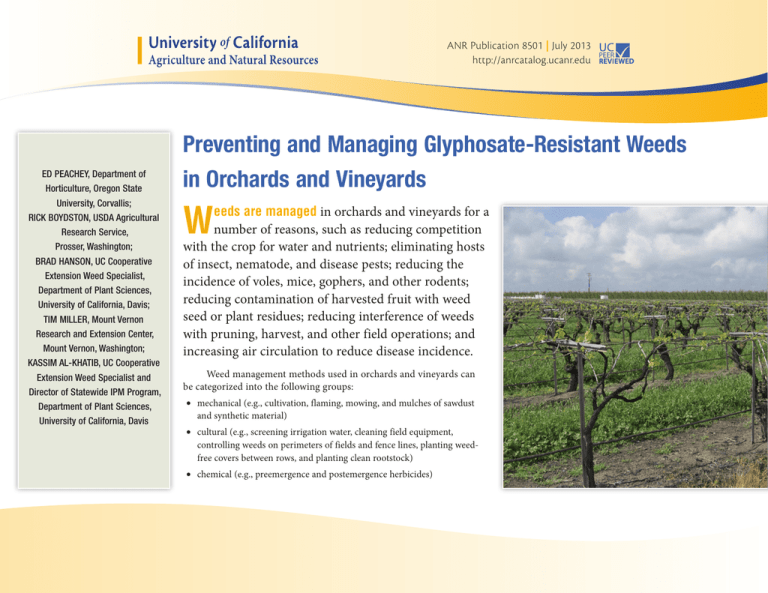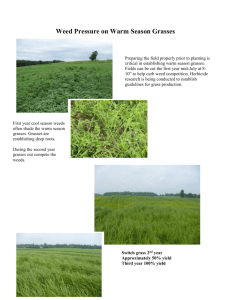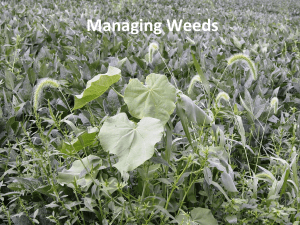
ANR Publication 8501 | July 2013
http://anrcatalog.ucanr.edu
ED PEACHEY, Department of
Horticulture, Oregon State
University, Corvallis;
RICK BOYDSTON, USDA Agricultural
Research Service,
Prosser, Washington;
BRAD HANSON, UC Cooperative
Extension Weed Specialist,
Department of Plant Sciences,
University of California, Davis;
TIM MILLER, Mount Vernon
Research and Extension Center,
Mount Vernon, Washington;
KASSIM AL-KHATIB, UC Cooperative
Extension Weed Specialist and
Director of Statewide IPM Program,
Department of Plant Sciences,
University of California, Davis
Preventing and Managing Glyphosate-Resistant Weeds
in Orchards and Vineyards
W
eeds are managed in orchards and vineyards for a
number of reasons, such as reducing competition
with the crop for water and nutrients; eliminating hosts
of insect, nematode, and disease pests; reducing the
incidence of voles, mice, gophers, and other rodents;
reducing contamination of harvested fruit with weed
seed or plant residues; reducing interference of weeds
with pruning, harvest, and other field operations; and
increasing air circulation to reduce disease incidence.
Weed management methods used in orchards and vineyards can
be categorized into the following groups:
• mechanical (e.g., cultivation, flaming, mowing, and mulches of sawdust
and synthetic material)
• cultural (e.g., screening irrigation water, cleaning field equipment,
controlling weeds on perimeters of fields and fence lines, planting weedfree covers between rows, and planting clean rootstock)
• chemical (e.g., preemergence and postemergence herbicides)
ANR Publication 8501 | Preventing and Managing Glyphosate-Resistant Weeds in Orchards and Vineyards | July 2013 | 2
Figure 1. In- and near-row cultivation in a vineyard.
Photo: R. Boydston.
Figure 2. In-row cultivators. Photo: R. Boydston.
• biological (e.g., releasing living organisms such as insects that
specifically inhibit growth or seed production of particular weeds)
Using multiple weed management tactics helps to prevent
a buildup of one or two dominant weed species that tolerate the
management method employed. It also helps prevent the increase
of individuals within a species that are resistant to the methods
used. Mechanical weed control can be the primary method of weed
control in vineyards and orchards, or it can complement the use of
herbicides and other methods. A timely cultivation often eliminates
many weed escapes following an herbicide application (figs. 1 and
2). Synthetic weed fabrics can eliminate many weeds and reduce the
use of herbicides, but they are expensive to install (fig. 3). Mulches
of sawdust, plant residues, paper products, or plastic can prevent
the emergence of many weeds, but they may harbor rodents or
other pests and are expensive to maintain. Repeated mowing can be
used to reduce weed seed production, and generally it will favor the
establishment of grass species.
Glyphosate is often used to manage emerged weeds within
the tree or vine row. Once applied, glyphosate is tightly bound
to soil and has no residual activity, so weed seeds that germinate
after glyphosate is applied can emerge and establish readily. Thus,
glyphosate must be used as part of an integrated and comprehensive
weed management program to obtain season-long weed control of
Figure 3. Weed mats in blueberry rows. Photo: R. Boydston.
later flushes of weed emergence. Multiple applications of the same
herbicide over time will select for weeds that tolerate that herbicide.
These weeds may be naturally tolerant of the herbicide, or the
weeds may have evolved resistance to the herbicide. Over time,
the frequency of the resistant or tolerant weeds in the population
will increase if the same herbicide is used repeatedly without using
any other control measures or herbicides with a different mode of
action. The mechanism by which herbicides kill plants is termed
mode of action or site of action. Due to the low cost of glyphosate
and its effectiveness on many weeds, it is tempting for growers to
eliminate other weed control practices or use of herbicides with
different modes of action.
A number of herbicides with soil residual activity are labeled
for use in trees and vines (tables 1 and 2). These herbicides prevent
annual weeds and sometimes perennial weeds from emerging or
establishing, but most often they do not kill weeds that have already
emerged. Combining an herbicide that has soil residual activity with
glyphosate or with another postemergence herbicide can greatly
extend the period of weed control and eliminate or greatly reduce
the need for multiple applications of glyphosate. Herbicides kill
plants by inhibiting specific physiological processes, often targeting
specific enzymes or proteins in plants. Using an herbicide with a
different mode of action (tank mixing or rotating use) helps reduce
ANR Publication 8501 | Preventing and Managing Glyphosate-Resistant Weeds in Orchards and Vineyards | July 2013 | 3
Table 1. Modes of action, weed control spectrum, and soil residual activity of herbicides labeled for use in vineyards and orchards
Active ingredient
Trade name
2,4-D
multiple names
acetic acid
MOA* group
MOA*
Weeds controlled
Soil residual activity
Uses
4
synthetic auxin
broadleaves
WeedPharm
n/a
leaf desiccation
broadleaves and grasses
no
carfentrazone
Aim
14
PPO inhibitor
broadleaves
no
clethodim
Select
1
ACCase inhibitor
grasses only
no
clopyralid
Stinger
4
synthetic auxin
broadleaves
limited
clove leaf oil
Matran
n/a
leaf desiccation
broadleaves and grasses
no
organic systems
dichlobenil
Casoron
20
cell wall synthesis inhibitor
broadleaves and grasses
yes
spot treatment perennials
diuron
Karmex
7
Photosystem II inhibitor
broadleaves and grasses
yes
fluazifop
Fusilade
1
ACCase inhibitor
grasses only
no
flumioxazin
Chateau
14
PPO inhibitor
broadleaves and a few grasses
yes
glyphosate
Roundup, others
9
EPSP synthase inhibitor
broadleaves and grasses
no
glufosinate
Rely
10
glutamine synthase inhibitor
broadleaves and grasses
no
halosulfuron
Sandea
2
ALS inhibitor
broadleaves, grasses, and sedges
yes
indaziflam
Alion
29
cell wall synthesis inhibitor
broadleaves and grasses
yes
isoxaben
Gallery
21
cell wall synthesis inhibitor
broadleaves
yes
napropamide
Devrinol
15
very long chain fatty acids inhibitor
grasses and some broadleaves
yes
norflurazon
Solicam
12
carotenoid biosynthesis inhibitor
broadleaves and grasses
yes
oryzalin
Surflan
3
microtubule assembly inhibitor
broadleaves and grasses
yes
oxyfluorfen
Goal
14
PPO inhibitor
broadleaves and a few grasses
yes
paraquat
Gramoxone
22
Photosystem I inhibitor
broadleaves and grasses
no
pendimethalin
Prowl
3
microtubule assembly inhibitor
broadleaves and grasses
yes
pronamide
Kerb
3
microtubule assembly inhibitor
broadleaves and grasses
yes
rimsulfuron
Matrix
2
ALS inhibitor
broadleaves and grasses
yes
saflufenacil
Treevix
14
PPO inhibitor
broadleaves
limited
sethoxydim
Poast
1
ACCase inhibitor
grasses only
no
simazine
Princep
5
Photosystem II inhibitor
broadleaves and grasses
yes
terbacil
Sinbar
5
Photosystem II inhibitor
broadleaves and grasses
yes
trifluralin
Treflan
3
microtubule assembly inhibitor
broadleaves and grasses
yes
limited
organic systems
nonbearing crops
nonbearing crops
nutsedge control POST
marestail, sharppoint fluvellin
willowweed (Epilobium spp.)
Notes: Check herbicide labels carefully to determine whether the herbicide is labeled for use in your area, for your crop, and for weeds that will be controlled.
*Mode of action: see the Weed Science Society of America (WSSA) website, http://wssa.net/wp-content/uploads/WSSA-Mechanism-of-Action.pdf, for a brief description of above-listed modes of action.
ANR Publication 8501 | Preventing and Managing Glyphosate-Resistant Weeds in Orchards and Vineyards | July 2013 | 4
Table 2. Herbicides labeled for use in citrus, nut, pome fruit, and stone fruit orchards and vineyards
Plum
Prune
Peach
NB
Nectarine
NB
Cherry
Apricot
Pear
NB
Stone fruits
Apple
Walnut
Pome fruits
Pistachio
NB
Nuts
Pecan
Grape
Hazelnut
Citrus
Chestnut
Common product name
Almond
Active ingredient
Kerb
simazine
Princep
terbacil
Sinbar
NB NB NB NB trifluralin
Treflan
NB NB
Time of application to weeds: PRE
dichlobenil
Casoron
diuron
Karmex
indaziflam
Alion
isoxaben
Gallery
napropamide
Devrinol
norflurazon
Solicam
oryzalin
Surflan
pendimethalin
Prowl
pronamide
NB NB NB NB
Time of application to weeds: PRE/POST
flumioxazin
Chateau
halosulfuron
Sandea
oxyfluorfen
Goal
Time of application to weeds: POST
2,4-D
acetic acid
WeedPharm
carfentrazone
Aim
clethodim
Select
NB
NB
NB
NB
NB
NB
NB
NB
NB
clopyralid
Stinger
diquat
Reglone
NB
NB fluazifop
Fusilade
NB
NB
NB NB NB NB
NB
NB NB NB
NB glyphosate
Roundup
glufosinate
Rely
paraquat
Gramoxone
pyraflufen
Venue
rimsulfuron
Matrix
saflufenacil
Treevix
sethoxydim
Poast
NB
NB
KEY
Shaded grey= labeled
White = not labeled
NB = nonbearing only
NB
NB
NB
NB
NB
NB
NB
NB
NB
NB NB NB
ANR Publication 8501 | Preventing and Managing Glyphosate-Resistant Weeds in Orchards and Vineyards | July 2013 | 5
the chance of glyphosate-resistant weed biotypes increasing in the
population.
• little or no cultivation or tillage for weed control or no elimination of
weeds that escape herbicide control
Some weed species have the ability to develop resistance to
glyphosate and other herbicides more quickly than others. Weed
characteristics conducive to rapid development of resistance to a
particular herbicide include
• continuous or repeated use of a single herbicide or several herbicides
that have the same mode of action
• annual growth habit
• high seed production
• relatively rapid turnover of the weed seed in the soil due to a high
percentage of seed germination each year (i.e., little seed dormancy)
several reproductive generations per growing season (e.g., Senecio
vulgaris)
• extreme susceptibility to a particular herbicide
• high frequency of resistant gene(s) (e.g., Lolium rigidum and
Amaranthus spp.)
The use of cultural practices can decrease the selective pressure
for the development of herbicide-resistant weed biotypes. In general,
complete reliance on herbicides for weed control promotes the
occurrence of herbicide-resistant weeds. Factors that increase the
likelihood of developing herbicide-resistant weeds include
• a high herbicide application rate relative to the amount needed for weed
control
• perennial cropping systems (e.g., orchard and vineyard systems and
roadsides) with no crop rotation
• There are currently 24 weed species reported to have developed
resistance to glyphosate around the world, and 14 of these are found
in the United States. Five glyphosate-resistant biotypes have been
reported in some grape production areas of California and Oregon:
hairy fleabane (Conyza bonariensis), marestail or mare’s tail (Conyza
canadensis) (fig. 4), Italian ryegrass (Lolium multiflorum), rigid ryegrass
(Lolium rigidum), and junglerice (Echinochloa colona).
• Strategies to Prevent and Slow Development of Herbicide Resistance
• Growers should monitor fields for weed escapes and determine if
escapes are multiple species or a single species. If there is a mixture
of species, the problem is more likely related to environment or poor
application. If escapes are primarily a single species, if herbicides
Figure 4. Glyphosateresistant marestail in
a vineyard undervine
strip.
Photo: B. Hanson.
Figure 5. Vineyard spray strips, Capay Valley, California. Photo: B. Hanson.
ANR Publication 8501 | Preventing and Managing Glyphosate-Resistant Weeds in Orchards and Vineyards | July 2013 | 6
previously controlled the species, and if a single herbicide has
been used repeatedly, the weed is more likely to be resistant. Do
not respray suspected resistant weeds with the same herbicide.
Collect seed from surviving weeds and have a university extension
specialist or crop consultant test for resistance.
• Elimination of weed seed production is the key to successful
weed management and should be practiced even if resistant
weeds are not present. In the event that herbicide resistance is
suspected, efforts to stop weed seed production become even
more important. If an herbicide-resistant species is identified
and confirmed, keep the weed from producing seed and clean
field equipment to prevent spreading the weed from one field
to another. Begin using cultivation, mowing, or herbicides with
a different mode of action to prevent the resistant species from
flowering and producing seed.
• Prevention is the most effective and economical method to
reduce the threat of glyphosate-resistant weeds. To prevent the
development of glyphosate resistance, several important steps need
to be considered, including
1. If glyphosate resistance is not present, use preemergence
treatments followed by a tank mix of postemergence products.
Also consider using other nonselective herbicides such as
glufosinate or paraquat tank mixed with PPO inhibitor
herbicides. These herbicides (also known as burndown
herbicides) kill plants on contact within a few hours or days.
2. To delay resistance from developing, use higher glyphosate rates
and do not cut the rate. The resistance is likely to be polygenic
(i.e., caused by several genetic changes in the plant, not just
one genetic mutation), and that requires higher rates. This is
contrary to other situations when growers are often asked to cut
the rate and reduce selection pressure.
3. If glyphosate resistance is present, growers may continue to
use glyphosate but should mix it with other herbicides that are
effective on the resistant weeds. Another alternative is to use
a different herbicide or combination of herbicides that do not
include glyphosate.
4. The level of glyphosate resistance is usually lower when weeds
are very small. If continuing to use glyphosate in orchards or
vineyards with resistant weeds, then tank mix glyphosate with
other herbicides and make the application when the weeds are
small.
5. Use other means to manage weeds, such as cultivation and
mowing in orchards. (See the section “Cultivation, Mowing, and
Other Nonchemical Control Methods” below.)
6. And, of course, do not let weeds go to seed.
• Cultivation, Mowing, and Other Nonchemical Control Methods
• Cultivation can be extremely helpful in preventing a shift to species
that are tolerant of herbicides or other weed control practices. Small
seedlings of many weeds are easily controlled with cultivation.
Cultivation equipment used in orchards and vineyards includes
narrow under-vine rototillers, small disk harrows, and a wide
assortment of tools designed to cut weeds off just under the soil
surface (see Lanini et. al. 2011 for a description of cultivation
equipment ). Like in the case of other weed management practices,
overuse of cultivation may increase cultivation-resistant species,
including perennial weeds. Cultivation equipment must be properly
set to make sure it does not damage roots or trunks. Shields around
tires and implements help minimize aboveground damage to trunks.
• Permanent sod strips are often used in orchards and vineyards
to improve trafficability and reduce dust. They also prevent
establishment of some weedy species, but they must be well
managed with mowing to prevent excessive water use. Flame
weeding with propane burners is occasionally used to suppress
weeds in orchards and vineyards. As with all weed management
techniques, overuse will result in a species shift and, in the case of
flame weeding, proliferation of grasses and perennial weeds. Flame
weeding is most effective in the late afternoon or when sunlight is
bright and air temperatures are high. Alternatives to open flame
propane weeders are infrared heaters and steam weeders that use
propane to generate heat.
ANR Publication 8501 | Preventing and Managing Glyphosate-Resistant Weeds in Orchards and Vineyards | July 2013 | 7
References
Lannini, W. T., G. T. McGourty, and L. A. Thrupp. 2011. Weed
management for organic vineyards: Cultivation. In G. T.
McGourty, ed., Organic winegrowing manual. Oakland:
University of California Agriculture and Natural Resources
Publication 3511. 74–76.
FOR MORE INFORMATION
To order or obtain ANR publications and other products, visit the ANR Communication
Services online catalog at http://anrcatalog.ucanr.edu or phone 1-800-994-8849. You can
also place orders by mail or FAX, or request a printed catalog of our products from
University of California
Agriculture and Natural Resources
Communication Services
1301 S. 46th Street
Building 478 – MC 3580
Richmond, CA 94804-4600
Telephone 1-800-994-8849
510-665-2195
FAX 510-665-3427
E-mail: anrcatalog@ucanr.edu
©2013 The Regents of the University of California
Agriculture and Natural Resources
All rights reserved.
Publication 8501
ISBN-13: 978-1-60107-855-1
The University of California Division of Agriculture & Natural Resources (ANR) prohibits
discrimination against or harassment of any person participating in any of ANR’s programs
or activities on the basis of race, color, national origin, religion, sex, gender identity, pregnancy (which includes pregnancy, childbirth, and medical conditions related to pregnancy or
childbirth), physical or mental disability, medical condition (cancer-related or genetic characteristics), genetic information (including family medical history), ancestry, marital status,
age, sexual orientation, citizenship, or service in the uniformed services (as defined by the
Uniformed Services Employment and Reemployment Rights Act of 1994: service in the uniformed services includes membership, application for membership, performance of service,
application for service, or obligation for service in the uniformed services) or any person in
any of its programs or activities.
University policy also prohibits retaliation against any employee or person participating in
any of ANR’s programs or activities for bringing a complaint of discrimination or harassment
pursuant to this policy. This policy is intended to be consistent with the provisions of applicable State and Federal laws.
Inquiries regarding the University’s equal employment opportunity policies may be directed
to Linda Marie Manton, Affirmative Action Contact, University of California, Davis,
Agriculture and Natural Resources, One Shields Avenue, Davis, CA 95616, 530-752-0495.
For assistance in downloading this publication, telephone 530-754-3927.
To simplify information, trade names of products have been used. No endorsement of named
or illustrated products is intended, nor is criticism implied of similar products that are not
mentioned or illustrated.
An electronic copy of this publication can be found at the ANR Communication Services
catalog website, http://anrcatalog.ucanr.edu/.
This publication has been anonymously peer reviewed for technical accuracy
by University of California scientists and other qualified professionals. This
review process was managed by ANR Associate Editor for Agricultural Pest
Management Joe Nunez.
web-7/13-LR/CR





